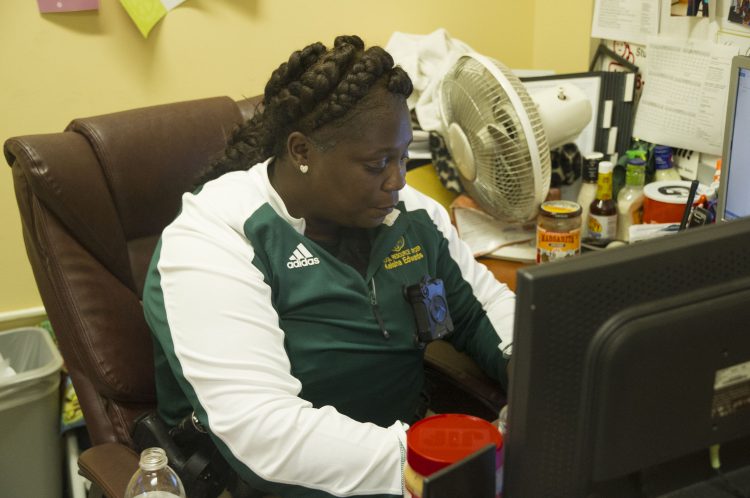In the halls, it’s not uncommon to see kids goofing off in the north commons or resting against the walls of the main hallway. Nor is it surprising to see them walking around and laughing with friends as they traverse the school.
Many times, these students have an Alternate Unassigned Time (AUT) period and are simply passing the hour at their leisure, but in other cases, they may be skipping class.
Students skip so often, RBHS now takes account for 40 percent of referrals related to truancy among the three high schools in the district.
Taken aback at such a large number, assistant principal Dr. Tim Baker said after a long discussion with other administrators, they decided to attempt to reduce the number of truancies by 10 percent.
RBHS’s strategy is to have administrators walk around the school and question students on whether or not they have a legitimate reason to be in the hallways or in a classroom. This is to comply with one of the district’s goals, which wants students caught up on class material as much as possible in order to learn more, Dr. Baker said.
“We’re so split up and so large around here, that a lot of times kids will just sit in the north commons, sit in the main commons, sit in the cafeteria, sit by the planetarium, whatever, and now that everyone’s got laptops, you can’t tell who’s on AUT [or] who’s skipping a class,” Dr. Baker said. “[Administration has] increased visibility quite a bit this year, and we’re all walking around all the time [asking students] ‘Are you in AUT?’ ‘Are you supposed to be in class?’”
After a student misses a class and the teacher records the absence, if it’s not excused by a guardian within 48 hours, the school system automatically marks the student as truant. This usually results in punishment by the school in the form of warnings, meetings or giving out referrals, Baker said.
“For a truancy, our policy is that [students] serve a detention approximately twice the length of what they skipped, so if they skipped a class, we usually take away like two AUTs and give them AUT detentions,” Dr. Baker said. “That’s basically our common practice.”
In the last school year, RBHS handed out 2063 referrals related to truancy, principal Dr. Jennifer Rukstad said. Although this number is staggering to senior Don Hammers, he said that he felt the administrators’ time could be better spent elsewhere rather than questioning students.
Hammers said there are stronger underlying problems with truancies, where students already “have the mindset of what they want to be in life,” and don’t show up to class simply because they don’t care or are concerned with something else.
“I know there’s kids that don’t really care about school for certain reasons,” Hammers said. “Like, something’s going on at home or something.”

At Hickman High School (HHS), these reasons are what the HHS administration tries to hone in on, HHS principal Tony Gragnani said. Compared with RBHS’s 40 percent of truancy referrals, truancies make up about 25 percent of all referrals at the other end of Providence Road.
By targeting these hidden issues that Hammers mentioned, HHS is able to facilitate a better learning environment, Gragnani said.
“At HHS, we work to make sure students have what they need to get to class on time,” Gragnani said. “We work with the students and their families to address the issue. If the issue continues, we will request [a] parent meeting, place students on attendance contracts and possibly limit the amount of time they can be in the hallways.”
Similar actions happen at RBHS should a student continually skip class, but the idea is to stop the truancy before an adult writes a kid up for it, Dr. Baker said. Hammers understands the reasons behind these questions, but believes that their efforts are in vain.
“I felt like [the increased visibility] was really pointless because [kids] will get annoyed by being told, ‘get to class on time’ and [will feel like the administration should] find something better to do,” Hammers said. “I feel like the administration going through the hallways, asking people to get to class is not going to help because if they don’t want to get to class on time, they won’t attempt to.”
Despite this hurdle, administrators will not stop trying to reduce truancies, Dr. Baker said. The entire purpose of increasing visibility and questioning students is not to constrict their freedoms, he said, but to make sure that they receive a proper education, as that is a responsibility RBHS has to its students.
“We’re trying to get kids in class more. That’s one of the district goals — get them in class, catch them up, [that sort of thing],” Dr. Baker said. “Our biggest goal is to reduce the amount of time that kids are out of class for any reason. The biggest bang for our buck is to reduce truancies. [At] this building, freedoms are massive here, so it’s easy to skip a class here if you lack the discipline. It’s pretty easy to walk out the door, you know? So that’s our focus: try to get them into class.”
LATEST NEWS
- Stress, anxiety skyrocket as students prepare for upcoming AP tests
- RBHS holds successful night of percussion
- Not even water?
- Solar eclipse to pass through Missouri, April 8
- How CPS is organized: a guide
- City of Columbia to hold school board election April 2
- Youth Election Participants to assist in upcoming municipal election
- City of Columbia hosts first Community Engagement Session for McKinney Building, hopes to gain public insight on the structure’s future
- RBHS Track Team Opener at Battle Gallery
- March Mathness Photo Gallery





















































































